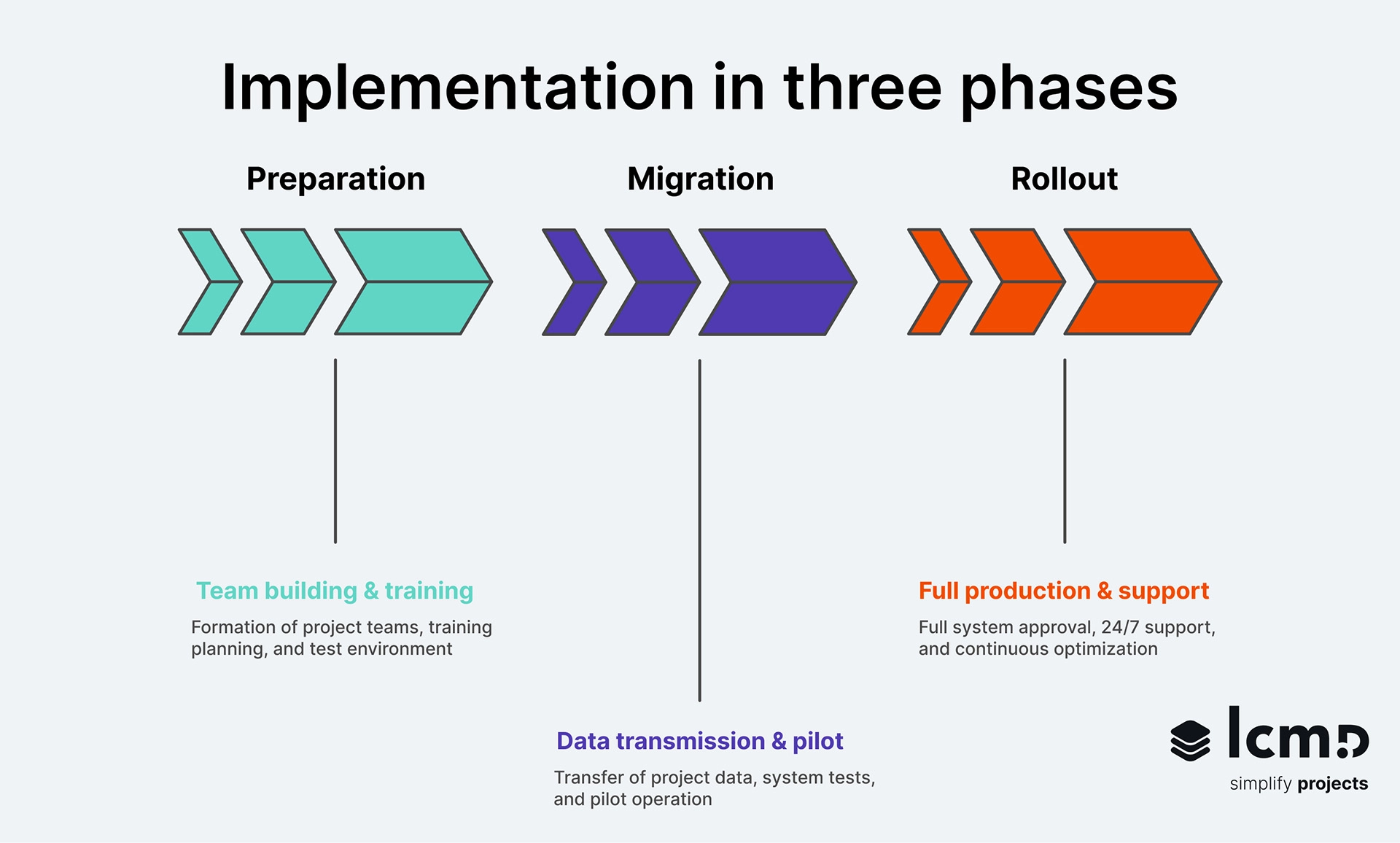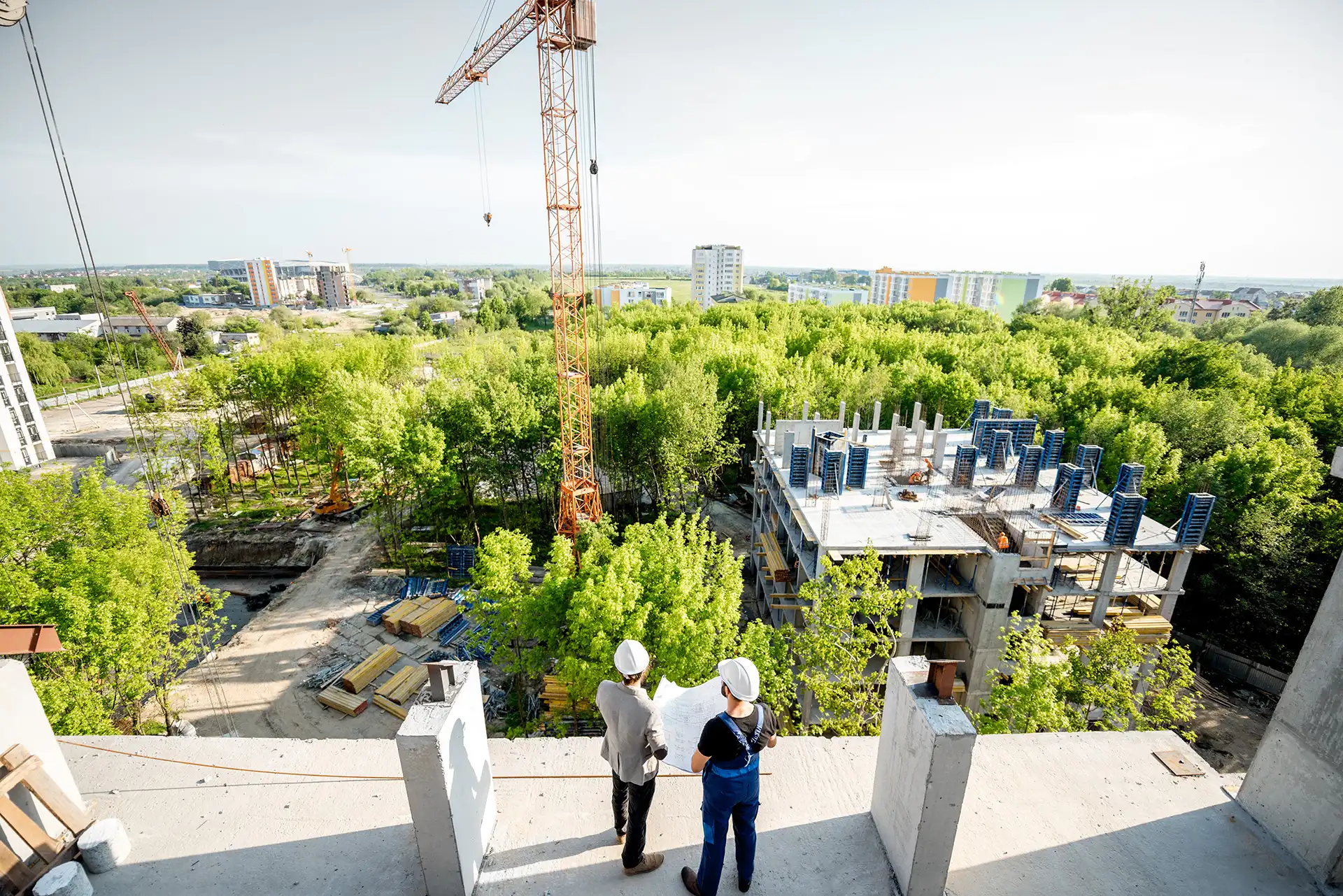Share this article:
Key Takeaways from this article
Here's the perfect irony: construction companies that make daily decisions about site development stumble over the same terms when digitizing their own operations.
Construction managers know the difference between developed and undeveloped land – yet many don't understand what Brownfield vs. Greenfield means for their project management software. This knowledge gap leads to costly mistakes in digitalization projects.
Why do Brownfield projects often fail right in the initial phase? And why do Greenfield projects lead to better long-term results but get chosen less frequently?
The answer isn't in the technology – it's in understanding the fundamental differences between these strategies. While architects and project managers make daily decisions about land use, they often lack clarity about digital migration paths.
The right choice between Brownfield and Greenfield determines the success of your entire digitalization strategy – and time is running out to make this decision.
Construction companies face a crucial decision when modernizing their project management software. Brownfield vs. Greenfield approaches determine digitalization success.
These strategies come from urban planning. Brownfield describes renovating existing industrial sites, Greenfield describes developing untouched areas. In construction, these concepts apply to software modernization and digitalization projects.
What Does the Brownfield Approach Mean?
The Brownfield approach uses your existing systems. Proven processes, data structures, and workflows stay in place and get gradually expanded.
Brownfield Characteristics in Construction Project Management
Brownfield projects have specific features:
Data preservation: All project histories and master data remain available.
Process stability: Construction managers work with familiar workflows.
Gradual integration: New features get added step by step.
Proven interfaces: Connections to subcontractors keep working.
Benefits of the Brownfield Approach
Brownfield strategies bring concrete advantages for construction companies:
- Quick implementation: Implementation takes 3-6 months. Construction managers can immediately work with the modernized software.
- Lower costs: Smaller initial investments make this approach attractive for mid-sized construction companies. No expensive new developments or extensive data migrations needed.
- Minimal training effort: Your team already knows the basics. Training focuses on new features instead of system transitions.
- Little operational disruption: Running construction projects aren't affected. Continuity during critical project phases remains intact.
Disadvantages of the Brownfield Strategy
Brownfield approaches also have limitations:
- Legacy issues persist: Inefficient processes from the past carry over.
- Limited innovation: Fundamental improvements are hard to implement.
- Higher maintenance costs: Legacy structures require more attention.
- Scaling limits: Company growth hits technical barriers faster.

The Greenfield Approach Explained
Greenfield projects start from scratch. Your project management system gets redesigned and implemented – without compromises from historically grown structures.
Greenfield Characteristics in Practice
Greenfield implementations are characterized by:
- Fresh start: Building without technical legacy or system constraints.
- Process design: Workflows match modern construction management standards.
- Current technology: Using contemporary developments like cloud computing and mobile applications.
- Future-ready architecture: The system grows flexibly with your company requirements.
Benefits of the Greenfield Approach
Greenfield strategies open new possibilities:
- Tailored processes: Construction project workflows can be redesigned without historical restrictions. HOAI performance phases get digitally mapped.
- Modern technology: Using current features like real-time collaboration, mobile apps, and cloud integration increases efficiency.
- High data quality: No outdated or inconsistent legacy data affects performance. Clean master data from day one.
- Best performance: The system works without legacy components and achieves high speed.
Challenges with Greenfield Projects
Greenfield implementations place higher demands:
- Higher initial investments for new development and data migration
- Longer project timelines of 6-12 months until implementation
- Intensive change management for the system switch
- Comprehensive training programs for all user groups in the company

Practical Comparison: Brownfield vs Greenfield
Technical Differences
The technical differences between Brownfield and Greenfield affect your project planning:
Cost Factors in Detail
Brownfield projects have lower startup costs by using existing infrastructure. However, Greenfield strategies often show better long-term economic efficiency, as maintenance costs and system performance positively influence total costs over the lifecycle.
Risk Assessment
Brownfield approaches have lower implementation risks but higher long-term operational risks. Greenfield projects carry more project risks but offer more stable long-term perspectives.
Decision Criteria for Your Construction Company
When to Choose Brownfield?
Brownfield works when:
- Functioning processes exist: Your current construction project workflows work well and need moderate improvements.
- Time pressure exists: Quick implementation is required to capture market opportunities or meet regulatory requirements.
- Budget is limited: Available funds don't allow extensive new developments or system transitions.
- Team resistance to change exists: Your employees are skeptical about changes and prefer proven, familiar workflows.
When to Prefer Greenfield?
Greenfield becomes the better choice when:
- Systems are outdated: Your existing software is technically obsolete and hinders efficient construction project execution.
- Growth plans exist: Planned company expansion requires flexible, scalable system architectures.
- Quality problems persist: Faulty processes in current systems affect project results and customer satisfaction.
- Innovation pressure exists: Competitive advantages through modern technologies are required for market positioning.
Hybrid Strategies: The Best of Both Worlds
Combinations of Greenfield and Brownfield create flexible solutions. According to the LeanIX SAP S/4HANA Survey, 14% of companies choose pure Greenfield approaches, while 44% prefer Brownfield strategies and 42% prefer hybrid approaches.
- Phased migration: Critical areas like scheduling get modernized first, secondary processes follow later.
- Risk minimization: Pilot projects test new approaches in non-critical construction projects.
- Flexible adaptation: Modular approaches enable response to changing market requirements.
- Cost optimization: Targeted resource allocation across different migration streams optimizes the budget.
Implementation for Construction Managers and Project Leaders
Structured Planning Phase Approach
Successful Brownfield or Greenfield projects begin with thorough preparation:
- Current state analysis: Current systems and processes get analyzed in detail. Strengths and weaknesses in project execution get identified.
- Goal definition: Clear, measurable goals get formulated. Success becomes quantifiable and oriented to HOAI performance phases.
- Resource planning: Personnel, budget, and schedules get realistically planned and coordinated with management.
- Risk analysis: Potential problem areas get identified and corresponding solution strategies developed.
Implementation in Three Phases
Both approaches follow proven implementation steps:
Phase 1: Preparation
- Team building with clear role definitions for construction managers, architects, and project managers
- Training planning for different user groups and experience levels
- Test environment for safe experiments without impact on running projects
Phase 2: Migration
- Data transfer: Brownfield takes over all historical project data, Greenfield migrates selectively
- System testing under realistic conditions with real construction project data
- Pilot operation with selected users and smaller projects
Phase 3: Rollout
- Full production after successful test completion and user acceptance
- 24/7 support for all users during the critical introduction phase
- Regular optimization based on user feedback and project insights

Success Factors in Practice
Both strategies succeed through proven principles:
Clear communication: All stakeholders stay regularly informed about goals, progress, and changes.
Structured project management: Proven BPMN 2.0 standards reduce chaos and create team trust.
Regular testing: Quality assurance prevents surprises in productive operation.
User orientation: Systems get developed to make daily work easier.
Optimization for Different Approaches
Optimizing Brownfield Projects
Brownfield strategies benefit from a structured approach:
- Process documentation: All current workflows get captured and structured according to HOAI performance phases. Improvement potential gets identified.
- Interface analysis: Critical connections to subcontractors, authorities, and other systems get mapped and checked for future viability.
- Gradual modernization: Changes happen in manageable stages to minimize risks for running construction projects.
- Regular improvement: Updates keep the system current and efficient.
Successfully Implementing Greenfield Projects
Greenfield implementations require special care:
- Detailed requirements analysis: All needs of construction managers, architects, and project managers get captured and prioritized.
- Prototyping: Early test versions enable adjustments before final development and reduce later change efforts.
- Intensive user testing: Real users from different company areas test all functions under realistic conditions.
- Agile development: The system stays flexible during development and can react to new insights.
The Strategic Decision for Your Company
Brownfield vs Greenfield – this decision shapes the digital future of your construction company. Brownfield projects offer quick, low-risk solutions with minimal training effort and proven processes. Greenfield projects create long-term competitive advantages through modern technologies and adapted workflows.
Your choice depends on four central factors:
- System quality: The condition of your current software determines modernization or rebuilding needs
- Available resources: Budget, personnel, and timeframe limit realizable options
- Timeframe: Available project duration influences feasibility of different approaches
- Company objectives: Long-term digitalization strategy defines the right direction
Conclusion
Digitalization won't wait – but the wrong Brownfield vs. Greenfield decision can cost you years.
Successful construction companies understand: there's no universal solution. Brownfield projects offer quick results with functioning systems, Greenfield strategies create long-term competitive advantages with outdated structures.
The reality? While you're weighing between Brownfield and Greenfield, your competitors are already digitalizing their processes. The market doesn't reward the perfect decision – it rewards the timely one.
Three critical questions decide your path: Do your current processes work? Do you have time for fundamental changes? Can you afford standstill?
Don't wait for the perfect moment. The construction industry is transforming now – with or without you. Start analyzing your Brownfield or Greenfield options today.



.svg)


.svg)
.svg)




